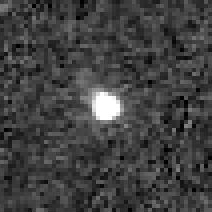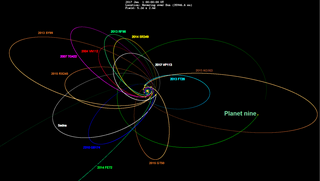Related Research Articles
(65407) 2002 RP120, provisional designation 2002 RP120, is a trans-Neptunian object and damocloid from the outer Solar System. Its orbit is retrograde and comet-like, and has a high eccentricity. It was discovered on 4 September 2002 by astronomers with the LONEOS survey at Anderson Mesa Station, Arizona, in the United States. The unusual object measures approximately 14.6 kilometers (9.1 miles) in diameter and is likely elongated in shape. It is a slow rotator and potentially a tumbler as well. The object was probably ejected from the ecliptic by Neptune.

(40314) 1999 KR16 is a trans-Neptunian object on an eccentric orbit in the outermost region of the Solar System, approximately 254 kilometers (158 miles) in diameter. It was discovered on 16 May 1999, by French astronomer Audrey Delsanti and Oliver Hainaut at ESO's La Silla Observatory in northern Chile. The very reddish object is a dwarf planet candidate and has a rotation period of 11.7 hours.
(589683) 2010 RF43, provisionally designated: 2010 RF43, is a large trans-Neptunian object orbiting in the scattered disc in the outermost regions of the Solar System. The object was discovered on 9 September 2010, by American astronomers David Rabinowitz, Megan Schwamb and Suzanne Tourtellotte at ESO's La Silla Observatory in northern Chile.
(445473) 2010 VZ98, provisional designation 2010 VZ98, is a trans-Neptunian object of the scattered disc, orbiting the Sun in the outermost region of the Solar System. It has a diameter of approximately 400 kilometers.
2010 TJ is a trans-Neptunian object from the scattered disc in the outermost region of the Solar System and measures approximately 460 kilometers in diameter. It was first observed by American astronomers David Rabinowitz, Megan Schwamb, and Suzanne Tourtellotte at ESO's La Silla Observatory in northern Chile on 2 October 2010.

(82158) 2001 FP185, provisional designation 2001 FP185, is a highly eccentric trans-Neptunian object from the scattered disc in the outermost part of the Solar System, approximately 330 kilometers in diameter. It was discovered on 26 March 2001, by American astronomer Marc Buie at Kitt Peak National Observatory in Arizona, United States.
(78799) 2002 XW93, provisional designation 2002 XW93, is a trans-Neptunian object and centaur from the outer Solar System, approximately 500–600 kilometers (300–400 mi) in diameter. It was discovered on 10 December 2002, by astronomers at the Palomar Observatory in California.
2013 RF98 is a trans-Neptunian object. It was discovered on September 12, 2013, at Cerro Tololo-DECam.
2013 GP136 is a trans-Neptunian object from the scattered disc in the outermost reaches of the Solar System, approximately 212 kilometers in diameter. It was discovered on 8 February 2013, by the Outer Solar System Origins Survey at the Mauna Kea Observatories on the island of Hawaii, United States.

2015 RX245 is an extreme trans-Neptunian object, detached, on a highly eccentric orbit in the outermost region of the Solar System. It measures approximately 250 kilometers (160 miles) in diameter and is "possibly" a dwarf planet. It was first observed on 8 September 2015, by astronomers with Outer Solar System Origins Survey using the 3.6-meter Canada–France–Hawaii Telescope at Mauna Kea Observatories, Hawaii, in the United States.
(505478) 2013 UT15 is an extreme trans-Neptunian object from the scattered disc, located in the outermost regions of the Solar System, approximately 260 kilometers (160 miles) in diameter. It was discovered on 2 August 2013, by astronomers of the Outer Solar System Origins Survey at Mauna Kea Observatory, Hawaii, United States.
2015 KH163, is a trans-Neptunian- and scattered disc object from the outermost region of the Solar System, approximately 117 kilometers in diameter. It was first observed by astronomers during the Outer Solar System Origins Survey at the Mauna Kea Observatories on 24 May 2015.
2005 RH52 is an extreme trans-Neptunian object from the extended scattered disc in the outermost region of the Solar System, approximately 130 kilometers (81 miles) in diameter. It was first observed on 3 September 2005, by astronomers with the Canada–France Ecliptic Plane Survey using the Canada–France–Hawaii Telescope at the Mauna Kea Observatories in Hawaii, United States.

2013 FS28 is an extreme trans-Neptunian object from the extended scattered disc on a highly eccentric orbit in the outermost region of the Solar System. It measures approximately 466 kilometers (290 miles) in diameter. The detached, extended scattered disc object belongs to the group of extreme trans-Neptunian objects. It was first observed on 16 March 2013, by American astronomers Scott Sheppard and Chad Trujillo at the Cerro Tololo Observatory in Chile.
(508338) 2015 SO20 is an extreme trans-Neptunian object and extended scattered disc object from the outermost region of the Solar System, approximately 220 kilometers (140 miles) in diameter.
2014 SS349 is an extreme trans-Neptunian and scattered disc object from the outermost regions of the Solar System, approximately 134 kilometers in diameter.
(543354) 2014 AN55 (prov. designation:2014 AN55) is a trans-Neptunian object in the scattered disc, located in the outermost region of the Solar System, that measures approximately 600 kilometres (370 mi) in diameter. It was discovered on 25 January 2014, by astronomers with the Pan-STARRS survey at Haleakala Observatory on the island of Maui, Hawaii, in the United States.

2015 BP519, nicknamed Caju, is an extreme trans-Neptunian object from the scattered disc on a highly eccentric and inclined orbit in the outermost region of the Solar System. It was first observed on 17 January 2015, by astronomers with the Dark Energy Survey at Cerro Tololo Observatory (W84) in Chile. It has been described as an extended scattered disc object (ESDO), and fits into the group of extreme objects that led to the prediction of Planet Nine, and has the highest orbital inclination of any of these objects.
(468861) 2013 LU28, provisional designation 2013 LU28 is a highly eccentric trans-Neptunian object, retrograde centaur and damocloid from the outer regions of the Solar System. It was discovered on 8 June 2013 by astronomers with the Mount Lemmon Survey at the Mount Lemmon Observatory in Arizona, United States. The object is unlikely a dwarf planet as it measures approximately 110 kilometers (68 miles) in diameter. It was numbered in 2016 and has not been named since.
2014 UE228 is a trans-Neptunian object from the outermost region of the Solar System. The object is in a rare 3:8 resonance with Neptune and measures approximately 93 kilometers (58 miles) in diameter. It was first observed on 22 October 2014, by astronomers with the Outer Solar System Origins Survey at the Mauna Kea Observatories, Hawaii, and was provisionally designated 2014 UE228. As of 2021, it has not been numbered.
References
- 1 2 3 4 5 "JPL Small-Body Database Browser: 506479 (2003 HB57)" (2017-04-02 last obs.). Jet Propulsion Laboratory. Retrieved 9 December 2017.
- 1 2 3 4 5 Johnston, Wm. Robert (15 October 2017). "List of Known Trans-Neptunian Objects". Johnston's Archive. Retrieved 16 November 2017.
- ↑ "List Of Centaurs and Scattered-Disk Objects". Minor Planet Center. Retrieved 9 December 2017.
- 1 2 "506479 (2003 HB57)". Minor Planet Center. Retrieved 9 December 2017.
- 1 2 3 4 Michael E. Brown. "How many dwarf planets are there in the outer solar system?". California Institute of Technology . Retrieved 30 July 2017.
- ↑ minorplanetcenter.net: q>30, a>150
- ↑ Sheppard, Scott S.; Trujillo, Chadwick (December 2016). "New Extreme Trans-Neptunian Objects: Toward a Super-Earth in the Outer Solar System". The Astronomical Journal. 152 (6): 18. arXiv: 1608.08772 . Bibcode:2016AJ....152..221S. doi: 10.3847/1538-3881/152/6/221 . S2CID 119187392.
- ↑ de la Fuente Marcos, Carlos; de la Fuente Marcos, Raúl (21 October 2016). "Finding Planet Nine: apsidal anti-alignment Monte Carlo results". Monthly Notices of the Royal Astronomical Society . 462 (2): 1972–1977. arXiv: 1607.05633 . Bibcode:2016MNRAS.462.1972D. doi:10.1093/mnras/stw1778. S2CID 119212828.